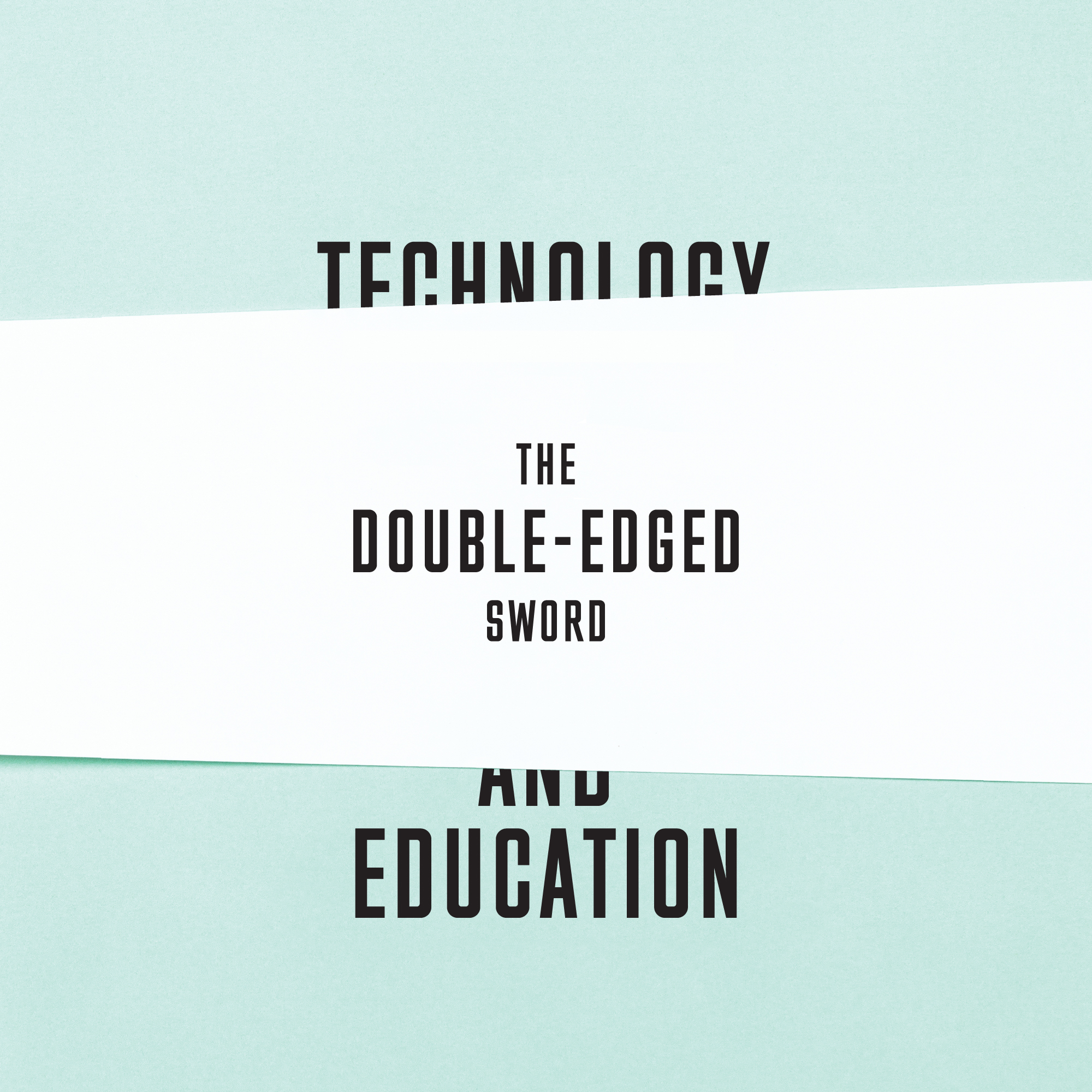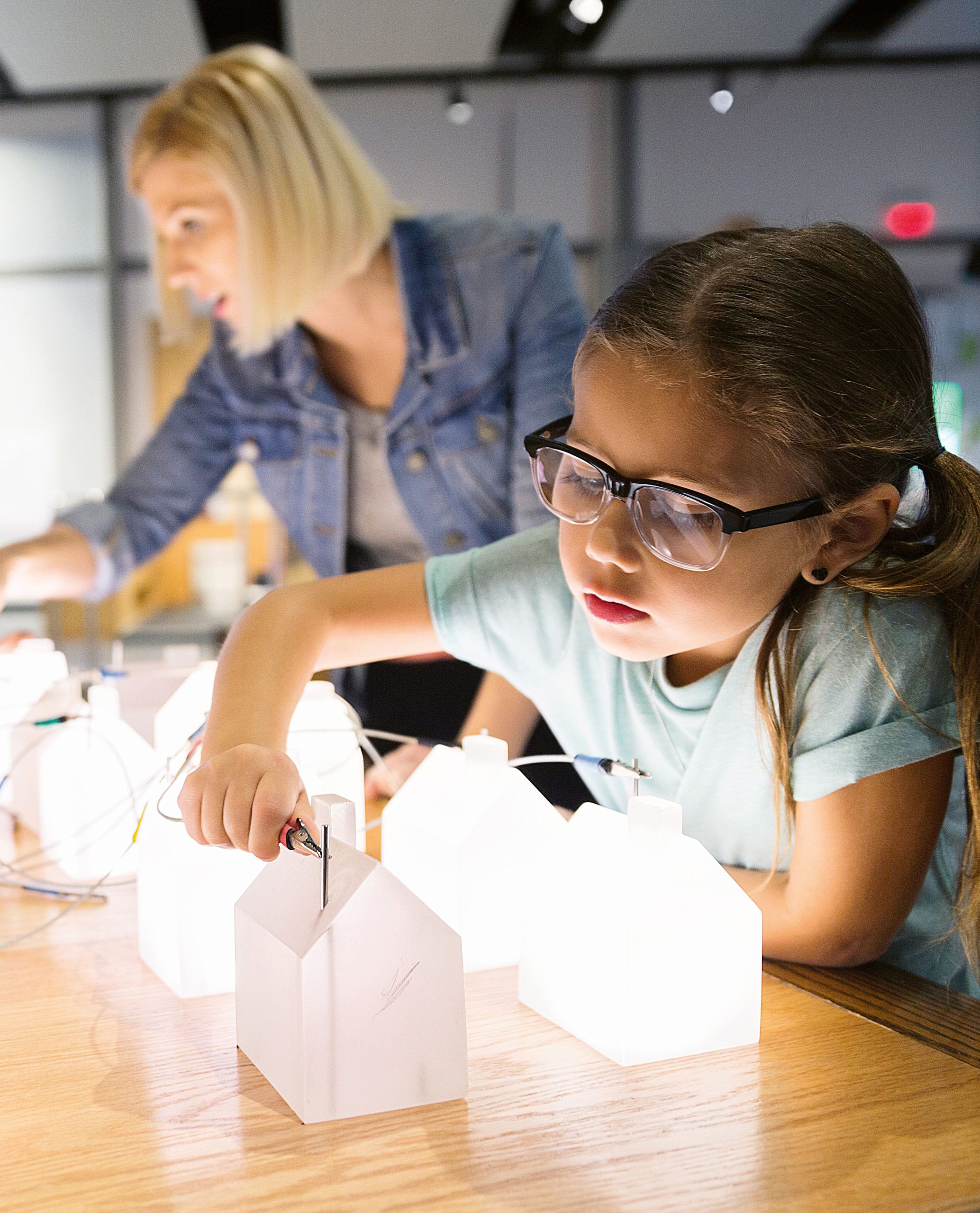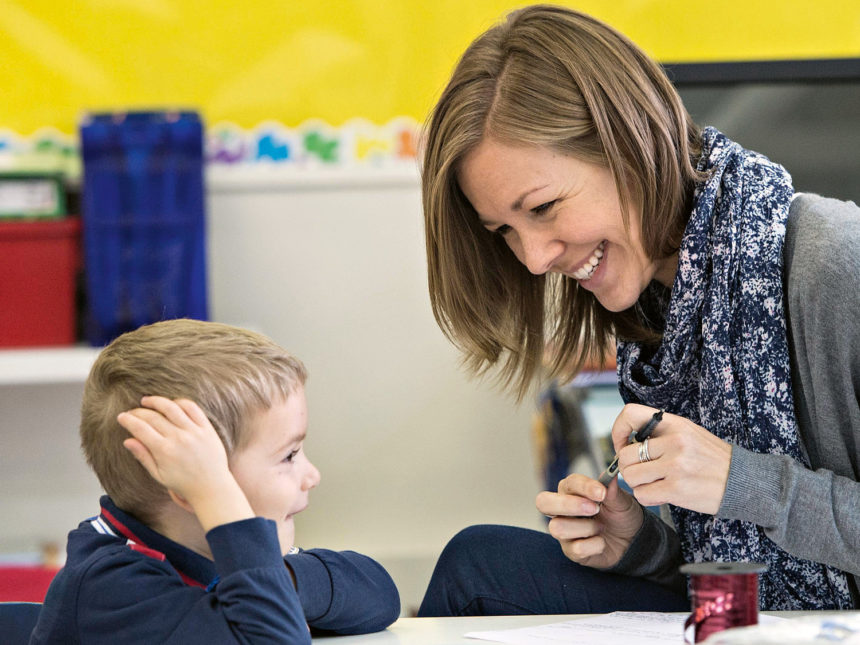
Technology
Technology and Education
The Double-Edged Sword
January 20, 2021
In a world of rapid change and unknown unknowns, the double-edged sword of technology has to be wielded with care by educators, so that
it becomes a force for good.
Rapid, disruptive cycles of change in many fields of human activity have been set in train by technology: the internet of things, biotechnological advances, robotics, and big data have come to be known as the 4th Industrial Revolution.
By Conrad Hughes
20/01/ 2021
·
- Share
Technology plays a central role in driving change at an ever-increasing, dizzying speed: the world population has quadrupled since World War II (from 2 billion to nearly 8 billion people) thanks to technological advances in medicine; the speed at which we are destroying the Earth is accelerating (we are exhausting well over 160 per cent of the planet’s biocapacity) because of rampant industrialization and technology-assisted overproduction; the concentration of power in the hands of fast-growing technology companies intensifies, while artificial intelligence now does stock market trading in micro-seconds, assisting multinationals in becoming massively powerful monopolies as they eat each other up.
This juggernaut of change creates different reactions in people: some look at it as a terrifying tornado spiralling closer and closer to a disastrous end, others view opportunity and access. Indeed, globalization, comparative ease of travel, the sharing economy, and communication networks enhanced by social media have made the world far more accessible than ever before. Many diseases that plagued humanity for centuries have been eradicated and extreme poverty is less acute on a global scale than it was 30 years ago.
At the same time, growth in income disparity and new forms of terrorism have further divided the planet’s population into separate enclaves, and extremist political views are again rearing their ugly heads, as many world leaders embrace xenophobic, protectionist, and segregationist beliefs, barring the gates of immigration that led to so much of the prosperity and opportunity in the Old World.
The world of today is one of VUCA (volatility, uncertainty, complexity, and ambiguity). It is also a world of paradox, for so much of what we see unfolding has positive and negative ramifications simultaneously: it is the age of the double-edged sword.
What it means to be an educator
At the centre of this technological whirlwind is the young person looking into the future.
In each child there is the promise of the powerful, ethical, creative, critical, and engaged adult she or he will become, not to mention the capacity she/he has to go further than our education systems allow right now. What a privilege to educate but what a responsibility, too. The decisions we take as instructors can help shape not only learners’ confidence but also the way they act, for the future of humanity. Building an educational voyage is not just a question of technology, pedagogy, and curriculum, it is a question of human relationships.

In each child there is the promise of the powerful, ethical, creative, critical, and engaged adult she or he will become.
We know enough today about the social and emotional brain not to fall into the trap of seeing education as a purely technical or rational exercise made up of short-cuts and tools. We understand, possibly better than ever before, that the psychodynamics of learning are fragile and subtle, and that they rely on the interpersonal dimensions of any relationship: trust, confidence, mutual respect, and shared passion. Teachers in the twenty-first century need to be domain specialists, facilitators of competences, and outstanding pedagogues whose practice is informed by research. They also need to be caring, to seek feedback from learners, to be sensitive to the specific, contextualised social dynamics of the group, open to new ideas, and compassionate. All of this must come before any mention of technology, for technology is a means, not an end.
The double-edged sword of the world of VUCA implies polyphonic teaching, a dance with ambiguity allowing learners to take ownership of the learning process, without dumbing down the sacred transmission of powerful concepts that bind everything together. And the double-edged sword of technology has to be wielded with care in this dance, so that it becomes a force for good.
IBE’s Seven Macro-competences
As we approach the first quarter of the twenty-first century, schools, universities, industries and society at large are asking fundamental questions about education. Various frameworks map out educating for skills rather than knowledge alone, along with the importance of mindset, values and wellness. At the same time, there is an increasing worldwide emphasis on the importance of design thinking, creativity, empathy, and problem-solving.
Developed through in-depth forecast analysis by some of the world’s most perspicacious thought leaders and academics, involving work with UNESCO Member States, the IBE’s seven macro-competences make up the mother framework that not only subsumes all other frameworks, but organizes constituent elements in a taxonomy explaining relationships, disaggregating domains, and presenting an entire educational process.
The IBE-UNESCO model allows us to conceptualise the educational voyage from environmental elements (“constituents”) through to application, as they are put in the service of developing the macro-competences, and, finally, to positive outcomes, as the model explains how this can create individual, collective, and societal impact for good.
Importantly, the macro-competences, which are stable and predictable for the foreseeable future, relate to micro-competences, which are more specifically defined according to context, and will change in emphasis and nature over time.
Artificial Intelligence
Artificial intelligence describes a machine-based pattern-recognition functionality that allows non-human constructs to perform higher-order human tasks such as interpretation of complex data, natural language recognition and production, complex task delivery, such as driving a car or playing games. A further and essential difference between artificial intelligence and simple computer programming is that the former entails what is called “machine learning”, in other words, a process whereby software gathers data on past operations, and synthesises and arranges the data to make predictions about future applications. This is very much the premise of the search engine, which is based on the hitherto exclusively human mental domains of association and comparison.
In some areas of human activity, lower-order functions of knowing and understanding, and even some higher-order thinking skills such as synthesis and inference-making, can effectively be done by software. However, we should not lose sight of the fact that the only possible premise for this type of computation is probabilistic and strictly data-driven; it is not harnessed from metaphysical entities that—at least for the time being—seem to be uniquely human (emotions, belief systems, motivation, ethics, judgement, aesthetics, subjectivity, culture, existential decision-making).
The machines that humans have built and the algorithms that drive them are challenging the uniqueness of some of the essential constituents of human intelligence. Humans are increasingly attached to devices and dependent on them. The implications of artificial intelligence are that some areas of human activity can be outsourced to machines whereas others cannot. This leaves a space for schooling to develop those skills and attributes that are uniquely human and cannot be taken over by artificial intelligence. These include relationships, culture, empathy, higher-order thinking and happiness.
At the same time, schools need to equip students with the competences necessary to use tools interactively and effectively. Grappling with singularity involves enhancing the micro-competences of digital literacy and data literacy, while celebrating different types of collaboration (the macro-competences of interacting with others, interacting in the world, and interactively using diverse tools and resources).

The implications of artificial intelligence are that some areas of human activity can be outsourced to machines, whereas others cannot. This leaves a space for schooling to develop those skills and attributes that are uniquely human and cannot be taken over by artificial intelligence.
Technology as an Enhancer of Learning
Central to the question of how to adapt education to the challenges of today’s world is how we use technology as an enhancer of learning. It is quite obvious that opportunities to differentiate instruction, to personalize learning, and to give access to information have been revolutionised by the World Wide Web.
Not only can students learn in online environments that allow teachers to assess the pace and progress of learning of each individual through a dashboard, they can find models, examples, other learners, and tutors online to help them better understand what they are learning. Massive open online courses (MOOCs) from the world’s best universities can be accessed, as can lectures and masterclasses by the world’s best instructors.
One must ask oneself what the purpose of lecturing is in today’s classroom, since any oral or face-to-face lecture can also be transmitted electronically. The so-called “flipped classroom”, where teachers concentrate on higher-order thinking, reflection, discussion, and Socratic dialogue in the classroom, while students watch films and do adaptive online assessments at home, seems like a natural pedagogy to endorse as it takes advantage of technology and accelerates processes that used to be implemented by the teacher, such as talking through information, outsourcing it to a more efficient platform.
Given the ubiquity of technology in the workplace and the fact that it will remain a central expression of work in the future, even if we are not sure exactly what kind of work that will be, it seems meaningless to have students draw graphs with pencils, stick photocopied pages into workbooks, and carry heavy textbooks in their backpacks in the twenty-first century.
Technology has the ability to revolutionise access to learning and deconstruct schools to the point where one must question their purpose. Surely, students can access everything they need, anywhere, anytime, and without the need for a physical teacher? In some ways, schools actually appear to be holding up young people’s integration into the technologically advanced world of work in the twenty-first century by forcing them to learn in antiquated, irrelevant modes.
Not so simple
At the same time, we know more about the neuroscientific dimension of learning today than we ever did before. Learning occurs when human beings are stimulated emotionally so that their cognitive engagement is optimal. That level of stimulation needs to be carefully balanced between the limbic and the cortical lines of attention to ensure a “sweet spot” of concentration. Essentially, it requires human interaction.
Furthermore, we have known since Vygotsky that learning happens in a social context and needs not only an emotionally engaged instructor who connects personally with each learner, but a certain climate and culture among the group of learners. This is difficult to achieve in a virtual environment where people are interacting with each other through screens.
Studies have shown that handwriting is a better way of coding and storing information than typing, while basic elements of learning, such as interleaving, spaced repetition and deliberate practise, need a coach, a physical presence to guide students through the story of learning that is much more subtle and complex than simply accessing information. Information needs to be coded, conceptualized, stored, and retrieved, and for this to be done well, a teacher is needed to help explain concepts, test them, engage students in exercises with one another and assess higher-order areas of cognition that algorithms struggle to accommodate, most online assessments being fairly wooden tools such as multiple choice tests. Interestingly, meta-analyses in education that show the correlations between innovations in the classroom and learning gains, such as those conducted by Hattie, Marzano, or the Sutton Trust, tend to feature technology quite low down, compared to uniquely human pedagogic skills such as direct instruction, mastery teaching, feedback, and collective teacher efficacy.
Clearly, a balance is needed, where the best elements of human interaction are coupled with the efficiency that technology allows: a classroom where passionate, cultivated, and highly competent teachers, who understand the importance of social psychology and cognitive psychology in learning, use cutting-edge platforms and tools to create engaging learning tasks and assessments.

A balance is needed where the best elements of human interaction are coupled with the efficiency that technology allows: a classroom where passionate, cultivated, and highly competent teachers, who understand the importance of social psychology and cognitive psychology in learning, use cutting-edge platforms and tools to create engaging learning tasks and assessments.
The dilemma of smartphones
Central to the debate on technology in schools is the use of smartphones. Should schools allow them or ban them? Debates on the subject are heated with different approaches practiced across the globe. Some districts or curriculum boards ban them, whereas others embrace the use of all types of technology. The argument is essentially that, on the one hand, excessive smartphone use has been shown to reduce grey matter, working memory capacity and long-term concentration, while, on the other, the purpose of education should be to bring young people up in an environment that prepares them for the world and since the smartphone is uniquitous in the modern world, these should be integrated into learning. Most schools have a restrictive approach, either partial or total.
Smartphone use is also an accelerator of social media use, which brings with it a number of issues, particularly cyberbullying, grooming, problems of self-esteem, and related anxiety. At the same time, social media allow for communities of learners to share ideas from different parts of the world, building up virtual communities of learners.
The use of technology in schools is thus a double-edged sword that looks and feels different in each context, and there can be no oversimplified, blanket approach. Context and overall school culture need to be considered in order to decide what is best.
Technology and Mindfulness
Many people in the modern world suffer from high levels of stress through hyperactive lifestyles that can become unhealthy and compulsive. Needless to say, the interference of new technologies in the average person’s life is a contributing factor that needs to be mediated sensibly. This has led to a number of responses, especially in schools, in the area of mindfulness.
While new-age attempts to spiritualize life through meditative practice are effective, other avenues that can lead to a mindful lifestyle are actually fairly simple and have been embedded in school programmes for years. Intense physical and artistic activity, drawing a learner’s entire being into a “zone” of concentration and a “flow” of seamless process, can very well have the effect of allowing the mind to gain focus and stress levels to drop. This is one of the reasons why all schools should continue to have strong arts and sports programmes. Mindfulness can be achieved if we help learners concentrate on developing their health and wellbeing. This also implies moments away from technology, when the lure of social media, the pixels of the computer screen, and the open laptop are discarded for learning experiences that are kinaesthetic.
Technology and Post-Truth Politics
The way that most of us use the internet in today’s world is to confirm bias: we seek confirmation of our beliefs and, with the amount of information circulating on the Web, there is a strong chance we will find it. This way of conducting research does not put the idea of truth and the exposure of falsehood at the centre of knowledge, leading to a process that is not intellectually rigorous or even necessarily honest.
Political developments, especially in the US and the UK, in the middle of the first quarter of the twenty-first century have led some to argue that truth does not mean what it used to, that we are entering a type of post-truth era, where communication strategies supersede the verity of what is being discussed.
We should be careful about how we grapple with information nowadays: there are approaches to knowledge construction that are essential in an age of sound bites and alternative, often false positions broadcast on social media. To be an informed critical thinker in the twenty-first century means to be a lifelong learner, the macro-competence that includes an attitude of humility and acceptance that we might be wrong. Another essential macro-competence to develop in this vein is multi-literateness, for, without truly mastering a domain, how can we ever be in a position to question it?

Intense physical and artistic activity, drawing a learner’s entire being into a “zone” of concentration and a “flow” of seamless process can very well have the effect of allowing the mind to gain focus and stress levels to drop.
Technology and Knowledge in the 21st Century
Because of new technologies and the way that knowledge is made available and distributed, some believe that we need to rethink what is taught in school entirely and perhaps teach less content, opening more time and opportunities for skills development. This debate has grown more and more acute.
While it is true that information is readily available through a simple smartphone with an internet connection, it is dangerous to imagine that we need to know less, for knowledge is a foundational building block of critical thinking, culture, and understanding. Students need to have historical, scientific, geographic, cultural, and artistic sensitivities to appreciate the world around them and defend a point of view. At the same time, they need to master languages and numeracy for those sets of knowledge to be readily available from long-term memory to apply fluidly in new circumstances.

Students need an environment where physical activity, artistic exploration, interpersonal skills development, and deep thinking are complemented by the use of new technologies, when and where appropriate, to accelerate learning and make it more powerful.
Conclusion
The age of artificial intelligence threatens not only routine labour but many white-collar jobs too. Algorithms are already seen as far more reliable than human lawyers, doctors, and life-coaches. Educational practice needs to place greater emphasis on higher-order thinking such as analysis, synthesis, evaluation, and creativity. One might add to these areas of thinking those non-outsourceable dimensions of human behaviour that involve ethics and values.
A number of strictly cognitive higher-order operations can be simulated and perhaps even transcended by algorithms, especially those that deal with logico-mathematical intelligence involving multivariate analysis, deduction and statistically-based predictions based on hard data. This does not mean that these skills will no longer be harnessed in schools but that they should be developed alongside what algorithms can already do. By learning alongside powerful software instead of spending time on what software can do already, students’ logical higher-order thinking can be driven to practical and creative applications of information or to modulate creative scenarios according to different contexts. For example, rather than asking geography students to go outside and count the number of cars that drive along a road, they can access this information—or similar information—through a quick computerized search and then spend more time guessing and debating what the traffic flow might be like in different contexts (good or bad weather, weekend or week, whether there were more or fewer public transport links covering the same route, or more or fewer schools and businesses in the vicinity).
Therefore, educating for higher-order thinking should be considered in the context of the rapidly expanding computational power, design acceleration, and automation that science, technology, engineering, and mathematics (STEM) can produce. Many processes involved in project development and in learning itself can be automated in line with Bloom’s taxonomy. For example, students can accelerate lower-order routines by using search engines to access references and key information quickly so as to spend more time and energy on synthesising; hand-plotting graphs does not seem necessary in an age of graph-plotting software; data gathering for subjects such as geography can be automated, allowing more time for pattern detection and analysis, while general knowledge and understanding in a number of subjects can be tested through random item selecting software.
A word of caution, though: students still need to learn and develop a strong basis of academic knowledge. In order to activate these higher-order thinking skills, they will need to read long, detailed, and well-written texts, learn historical facts, and master many concepts.
On the other hand, because automatable thinking skills are reaching higher rungs of cognitive architecture with software capable of driving stock-market decisions, medical analyses, or legal opinion, schools need to focus on facets of being that are dispositional, teaching not only social intelligence but ethical decision-making, entrepreneurship, and innovation. Most schools claim to do this in one form or the other, but how many have the courage to insert into their actual curriculum, formal assessment, and timetabling the learning experiences that will allow these competences to flourish? Most national curricula are made up of academic subjects, high-stakes examination preparation, content testing, and a strong culture of grading, but do not deliberately and openly assess character or take students off timetable to work on macro-competences such as lifelong learning or self-agency, interacting with the world or interacting with others. One programme that does this is the International School of Geneva’s Universal Learning Programme, developed in conjunction with the IBE.
All in all, a balanced approach is needed, one that allows access to technology but also protects students from too much technology; an environment where physical activity, artistic exploration, interpersonal skills development, and deep thinking are complemented by the use of new technologies, when and where appropriate, to accelerate and make learning more powerful. Technology is a double-edged sword, it always has been. May it be handled with care.

